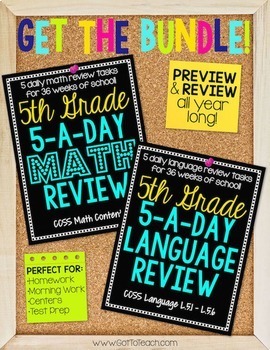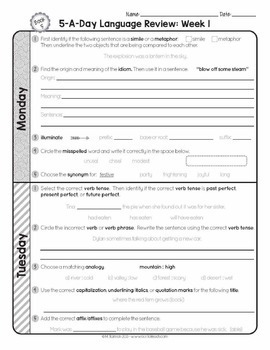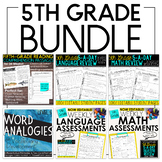5th Grade Daily Math and Language Spiral Review Bundle
- Zip
What educators are saying
Products in this Bundle (2)
Also included in
- This bundle includes my most popular fifth grade resources: math spiral review, math assessments, language and grammar spiral review, language and grammar assessments, reading comprehension passages for the entire year, and 5th-grade work analogies. For a detailed overview of what's included, pleasePrice $58.23Original Price $90.99Save $32.76
Description
Daily Math and Language Reviews for the Entire School Year!
This spiral review is one of the easiest ways to make sure you are covering all of the important concepts that your students need to know. Perfect for morning work, “bell-ringers,” homework, center work, or test prep. This resource is designed to be used on a daily basis (Monday-Thursday) for up to 36 weeks. PREVIEW and REVIEW all year long!
The language review is now EDITABLE!!! Easily edit the student pages using PowerPoint! (Editable math review is coming soon)
Language Skills Covered:
•Interpreting Similes and Metaphors (L.5.5a)
•The Origins and Meanings of Idioms (L.5.5b)
•Greek and Latin Affixes and Roots (L.5.4b)
•Spell Grade-Level Words Correctly (L.5.2e)
•Synonyms and Antonyms (L.5.5c)
•Form and Use Perfect Verb Tenses (L.5.1b & C)
•Recognize and Correct Verb Tenses (L.5.1d & C)
•Analogies- Word Relationships (L.5.5c)
•Titles of Work- Quotations, Underlines, and Italics (L.5.2d)
•Correctly Use Affixes (L.5.4b)
•Multiple Meaning Words (L.5.4c)
•Comma Usage (L.5.A-C)
•Coordinating and Subordinating Conjunctions (L.5.1a)
•Use a Pronunciation Key (L.5.4c)
•Adages and Proverbs (L.5.5b)
•Correlative Conjunctions (L.5.1e & L.5.3a)
•Prepositions and Verb Phrases (L.5.1e)
•Use Context Clues to Determine Word Meaning (L.5.4a)
Math Skills Covered:
•Write and Interpret Numerical Expressions (5.0A.2)
•Multiply Decimals (5.NBT.7)
•Add & Subtract Fractions (5.NBT.7)
•Place Value (5.NBT.1)
•Powers Of Ten Exponents (5.NBT.2)
•Place Value (5.NBT.3)
•Converting Units (5.NBT.2 & 5.MD.1)
•Operations with Multi-Digit Numbers (5.NBT.5 & 6)
•Areas of Rectangles with Fractional Side Lengths (5.NF.3B)
•Graph Points (5.G.A)
•Analyze and Interpret Patterns (5.0A.3)
•Multiply Whole Numbers & Fractions (5.NF.3 & 4A)
•Compare Decimal Numbers (5.NBT.1 & 3)
•Add & Subtract Decimal Numbers (5.NBT.7)
•Divide Decimals (5.NBT.7)
•Multiply Fractions (5.NF.4A & 5B)
•Rounding Decimal Numbers (5.NBT.4)
•Attributes of 2-Dimensional Shapes (5.G.3 & 4)
•Multiply and Divide by Powers of Ten (5.NBTt.1 & 2)
•Division with a Unit Fraction and a Whole Number (5.NF.7)
•Fraction Word Problems (5.NF.2 & 3)
•Order of Operations (5.OA.1)
•Improper Fractions-Mixed Numbers
•Multiply Mixed Numbers (5.NF.6)
Get all the latest Teacher Thrive news!
➜FOLLOW me on Teachers Pay Teachers!
➜FOLLOW me on TeacherThrive.com!
Please read: This is a nonrefundable digital download. Please read the description carefully and examine the preview file before purchasing.
© Copyright 2018 M. Tallman. All rights reserved. Permission is granted to copy pages specifically designed for student or teacher use by the original purchaser or licensee. This is intended to be used by one teacher unless additional licenses have been purchased. The reproduction of any other part of this product is strictly prohibited. Copying any part of this product and placing it on the Internet in any form (even a personal/classroom website) is strictly forbidden. Doing so makes it possible for an Internet search to make the document available on the Internet, free of charge, and is a violation of the Digital Millennium Copyright Act (DMCA).





